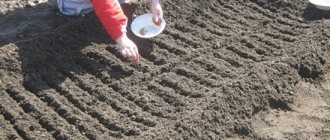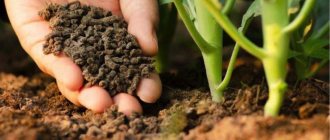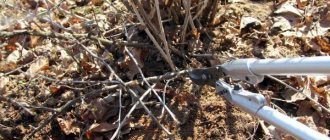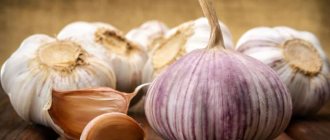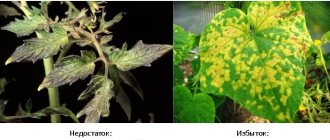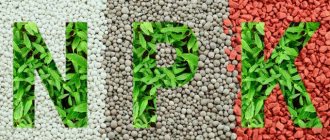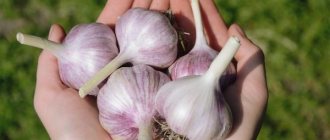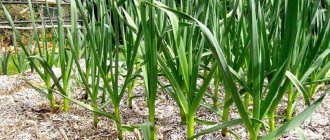For the most part, garlic in Russia is planted before winter. The winter variety of this vegetable is considered tastier than the spring variety. In addition, it is the winter vegetable that is recommended to be used for seaming.
Dear readers! For you, we have created communities on social networks in which useful articles and interesting ideas are published several times a day! Subscribe and receive useful content in a convenient format!
Winter is a serious test even for such a cold-resistant plant as garlic. Therefore, before planting in the future bed, it is necessary to add certain fertilizers.
In today's article we will talk about which nutritional formulations to use, at what time and in what volume.
How to prepare a bed for planting garlic in the fall
Half the success when planting in the fall is choosing the right place and preparing it.
Let’s say right away that it is extremely undesirable to grow a crop in one area for 2 years in a row. The vegetable must be returned to its original site once every 4 years.
The place where you are going to plant garlic should be slightly higher than the rest of the garden. With this planting, melt water from the snow will not cause the heads to rot.
The soil under future garlic beds must be dug up using a spade. It is necessary to remove all weeds and plant roots.
Some summer residents disinfect the soil with copper sulfate. To do this, they dissolve a tablespoon of the drug in a bucket of water and water the ground from a watering can.
IMPORTANT! This procedure must be carried out at least a month before planting the vegetable.
In general terms, the algorithm for preparing garlic beds is as follows:
- In a couple of months, green manure is planted.
- After 30-50 days, the green manure is removed and buried in the ground.
- The soil is disinfected.
- Digging and adding nutrients.
After all these agrotechnical measures, the site can be considered completely ready for planting garlic.
Effect of garlic
It's almost time to harvest the garlic. Some people like to eat kilos of it. Is it possible? Yes, it helps strengthen the body against various diseases (viral, temporary decrease in blood cholesterol, cardiovascular diseases), prevents the development of harmful bacteria (yeast, staphylococci, various bacilli), produces protein that helps protect the body from adverse effects, reduces blood viscosity and helps prevent heart attacks, strokes, and helps lower blood pressure.
But you shouldn’t include garlic in the list of the healthiest vegetables! It also has quite a lot of disadvantages. For example, smell. Even if you eat a small amount of this product (one slice is enough), your breath will not have a very pleasant odor. Doctors prohibit the use of this vegetable if there are problems with the liver, stomach, or kidneys. After all, the content of toxic elements leads to the destruction of the walls.
It is possible to cause an epileptic attack (if seizures have been noticed previously). By the way, garlic also does not bring much benefit to the brain. Scientists have done many experiments that prove that this interesting, rather unusual vegetable inhibits the functioning of the brain. Why? The poison contained in it acts on the membranes of organs.
After which green manures can garlic be planted?
The most advanced summer residents grow green manure on their plot before planting vegetables. This is a very effective solution for saturating the soil with nutrients, increasing soil fertility and even disinfecting it.
There are many green manures. Garlic is “friends” with almost all of them.
Most of all, the culture “loves” mustard. This green manure repels pests.
The plant can also be planted after phacelia and barley. The first green manure significantly improves the quality of the soil. Barley is not so useful, but the soil underneath it “rests.”
IMPORTANT! Green manure must be removed at least 2 weeks before planting garlic so that it has time to decompose in the soil.
Friendship or not?
Most of all, this vegetable hates fresh manure as fertilizer, especially when there is a lot of it. After it, the teeth will be loose, and will also crumble, like after unripe humus. The roots of this wonderful vegetable are very fragile and it should be remembered that a large amount of manure will be harmful. If nothing was planted before the garlic, then you need to dig a hole and fill it with 0.5 excrement and water (50/50) to make the soil more fertile. Professional gardeners say that you can fertilize three times per season.
The first time should be filled with melted soil or after the sprouts have risen. If the soil is completely dry, it will be necessary to increase fertilizing and watering. During the second “feeding” you don’t have to use valuable fertilizer, because it will greatly complicate the work of the roots, so you need to feed it with others. The third time, you should only water a little so that there are more nutrients in the ground and the roots little by little take what they need and preserve the harvest.
Everything and everyone requires care and attention, but you shouldn’t abuse it. May the harvest be full and the garlic large. Don't forget that you need to know moderation in everything. And fertilizer is not the only aspect in this.
Garlic. Preparing the soil for planting
What organic fertilizers are used for autumn planting of garlic?
Organic matter is not applied directly into the furrows when planting cloves in the fall. However, these fertilizers are applied 14-30 days before. At this time, site preparation should be carried out.
Most often, preference is given to organic manure and wood ash. Manure significantly increases soil fertility and “warms” garlic cloves all winter, and ash nourishes the crop with essential mineral compounds.
However, other organic fertilizers are also used: humus, chicken manure, green manure tops.
ON A NOTE. For greater efficiency, organics are mixed with minerals.
Mineral fertilizers
We should not forget about industrially produced mineral fertilizers for garlic in the fall. They quickly eliminate the deficiency of micro and macronutrients in the soil, creating an environment favorable for the growth of garlic. When using them, it is important to choose the desired form and control the amount of fertilizer applied.
Nitrogen-containing
This type of fertilizer is represented by ammonium nitrate, urea, ammonium sulfate and others. Urea is most often used when growing garlic. It is a complete source of nitrogen, containing up to 46% of the active substance. It is used for pre-planting soil treatment and foliar feeding. The addition of urea not only promotes the active growth of the vegetable, but also strengthens its immunity and protects against fungal diseases. The amount of application depends on the quality of the soil:
- for an area rich in organic matter, only 20 g/m2 will be required;
- for a depleted area - up to 40 g/m2.
Attention! Urea, like other nitrogen-containing fertilizers for winter garlic, is applied only in the spring - before the heads begin to form.
Phosphorus-containing
This type of fertilizer primarily includes superphosphate. Its use becomes especially relevant at the moment of formation of garlic heads. This fertilizer contains up to 20% phosphorus and helps improve the quality and quantity of the crop, accelerates the development of plants, and protects them from diseases. For this purpose, it is used for foliar feeding, simply scattered over the surface of the bed.
Potassium-containing
This type of fertilizer is represented by potassium magnesium, potassium sulfate, and kalimag. Their application helps to improve the quality and fertility of the soil, increase immunity, frost resistance and productivity of plants. The application rate when preparing the soil for planting is 30-60 g/m2, for foliar feeding – 10 g/m2.
Attention! Phosphorus-potassium fertilizers are used throughout the growing season of garlic; their application will be especially useful during the period of planting and growth of heads.
Special mention should be made of complex fertilizers, such as nitroammophoska, azofoska, ammophoska, containing the main nutrients - NPK. They are also used for pre-sowing treatment and foliar feeding. In order for mineral fertilizers added to the soil to bring maximum benefits to garlic - improve its marketability, keeping quality and productivity, they should be used together with organic fertilizers.
The application of fertilizers allows you to adjust the environmental conditions in which vegetables are grown. You can increase the fertility of the site, create conditions for a good harvest, strengthen the immunity of garlic, protecting it from fungal diseases by wisely combining and using mineral and organic fertilizers in a timely manner. Large heads obtained after harvesting and their long-term storage will be the best reward for the gardener.
How to properly apply manure when planting garlic in the fall
Manure can be applied with caution in the fall. But there are two important nuances.
- The manure must be rotted.
- It is necessary to apply manure when preparing the soil a month before planting.
The consumption rate is approximately 5-6 kg per square meter of area.
It is impossible to apply manure in the fall directly during planting, since it will cause the plant to “fatten”, that is, to increase green mass.
But in general it is better to feed manure in the spring than in the fall.
Treatment of teeth before planting
Garlic is susceptible to various fungal and viral infections. Pathogens often remain on vegetable cloves intended for planting, and when favorable conditions arise, they begin to actively develop on young plants. Any disease reduces yield or can lead to crop death. Therefore, it is important to disinfect the cloves before planting.
An aqueous infusion of ash - lye - is suitable for this task. To prepare it, dissolve 400 g of ash in 2 liters of water and boil for 30 minutes. The finished lye is cooled to room temperature.
For planting, only dense and strong cloves with a solid shell are selected. Selected planting material is immersed in ash broth for 2 hours. After this they are planted in the ground.
Additionally, microelements from the fertilizer work as growth stimulants, ensuring rapid plant growth at the beginning of development.
What to put in a hole with winter garlic so that the head is large
If the garlic has a small head, it means it lacks minerals. To prevent this from happening, fertilizers are applied precisely during planting.
There can be a lot of options here. These include chemicals. For example, potassium salt, phosphate rock, potassium sulfate, superphosphate. Mineral complex compounds – ammophoska, nitrophoska. Organic fertilizers - ash, humus.
Of all the variety, it is better to give preference to nitrophoska (1 matchbox per square meter of beds) or ash (0.5 kg for the same area).
Pest Control
Garlic is most often attacked by onion fly, root mites and stem nematode. Pests can reduce yields, spoil the bulbs, and, if severely damaged, lead to the death of plantings.
To treat affected garlic, prepare an ash-soap solution. To do this, 300 g of ash is poured into 10 liters of water and brought to a boil. Add 50 g of laundry soap in the form of shavings to the strained broth for adhesion.
The affected garlic is treated with a sprayer until completely wet. Additionally, the soil can be powdered with ash powder. Depending on the number of pests, up to 5 treatments may be needed. The interval between spraying is 5-6 days.
Many gardeners prepare ash in advance, store it in a dry place and use it during the season to feed vegetable crops. To do this, it is convenient to burn plant and wood components in large metal containers. This prevents the spread of fire and the dispersion of ash by the wind.
Feeding and fertilizer application schemes
Carry out only 1 fertilizing when planting garlic. This is done during soil preparation. In the fall, it is advised not to add organic matter and minerals separately, but to prepare complex mixtures.
The following feeding schemes are possible:
- 5 kg of humus (rotted manure, compost), 20 g of superphosphate, 15 g of potassium sulfate;
- 5 kg of humus, 20 g of superphosphate;
- 5 kg of compost, 35 g of double superphosphate, 25 g of potassium salt;
- Half a bucket of humus, 30 grams of superphosphate, 1 gram of potassium salt, 10 kg of peat (for clay soils);
- 10 kg of humus, 500 g of ash, 30 g of potassium sulfate, 15 g of superphosphate.
As you can see, almost every scheme involves the application of potassium and phosphorus fertilizers along with organic matter.
Fertilizing during the growing season for winter and spring garlic
During the growing season, various types of fertilizing are used, but their principle remains unchanged.
Feeding scheme in open ground
- in the first half it is mainly nitrogen nutrition for the development of vegetative mass;
- in the second half - phosphorus-potassium nutrition for tying heads and their ripening.
The timing of the first and second fertilizing in open ground for winter and spring garlic may coincide in time, and for the third fertilizing the time is chosen taking into account the fact that winter garlic ripens earlier.
If you are late with the third feeding, the plant will spend more energy on the formation of green mass and shoots, to the detriment of setting heads.
Based on the state of the vegetable crop, the last fertilizing of winter garlic is best done from mid to late June.
Attention! It is already useless to fertilize during the period when the plants enter the ripening stage and the leaves begin to turn yellow.
The second feeding with nitroammophoska (at the rate of 2 tbsp per 10 liters of water) - 12-14 days after the first.
For the third feeding, you can use the following options:
- superphosphate - 1.5 tbsp. l., 1 glass of ash per 10 liters of water (up to 5 liters of solution are used per 1 m²);
- superphosphate - 2 tbsp. l. per 10 liters of water (the solution is used per 2 m²);
- superphosphate - 30 g, potassium sulfate - 15 g per 10 liters of water (2 liters of solution are consumed per 1 m²).
Organic fertilizers
- Ash.
It will complement both organic and mineral fertilizers well. It is introduced in different ways:
- dust the soil and even leaves with dry ash;
- water the plants with ash solution;
- used for foliar feeding.
During the growing season, you can carry out 3-4 fertilizing with ash.
- Chicken droppings.
It is a very concentrated organic fertilizer, so it needs to be used in small doses.
To prepare liquid fertilizer, one part of litter requires at least 20 parts of water. Fresh chicken manure is not used for garlic; it is mixed with peat, sawdust or straw, kept and applied at the rate of 50 g of manure per 1 m².
Mineral
- Urea.
It is used for the first spring feeding if organic fertilizers are not used. The solution is prepared at the rate of 1 tbsp. l. for 10 liters of water. For 1 m² of area you will need an average of 2.5-3 liters. Feeding dates:
- winter garlic - two weeks after germination;
- spring garlic - in the phase of 3-4 leaves.
- Ammonium nitrate.
It is often used instead of urea when first feeding winter garlic when the snow melts. Scatter 1 tbsp per 1 m². l. dry fertilizer and incorporated into the soil.
- Superphosphate.
Stimulates the formation of heads and also promotes their maturation, therefore it is used as a third feeding at the end of June. Superphosphate dissolves slowly in water, for this reason the prepared solution (made from 10 liters of warm water and 2 tablespoons of fertilizer) is kept for 24 hours until completely dissolved. The application rate per 1 m² is up to 4 liters.
Complex
Nitroammofoska is perfect for the second feeding, which is carried out 12-14 days after the first. For 1 m² of area, use 3-4 liters of solution (2 tablespoons per 10 liters of water).
Foliar feeding
If, as a result of unfavorable conditions, plants need to quickly replenish their nutrition, foliar feeding is used, that is, spraying a fertilizer solution over the surface of the leaves. This allows the vegetable crop to absorb nutrients faster than with root feeding.
The concentration of fertilizers should be low to prevent leaf burn.
Spray garlic in dry, cloudy weather or in the evening. During the active growing season, no more than two foliar feedings are carried out. They do not replace root feeding, but are a supplement to it.
Fertilizer consumption rates depending on soil table
Different types of soil require different amounts of fertilizer when planting crops in the fall. It is logical that chernozem is much more fertile than loam, and therefore requires less fertilizing.
The table contains fertilizer consumption rates for different types of soil.
| Soil type | Amount of fertilizers per 1 sq.m. |
| Loams | A bucket of humus, 0.2 kg of wood ash, 1 tablespoon of nitrophoska, 1 tablespoon of superphosphate |
| Heavy clay soils | 10 kg of humus, 10 kg of peat, 0.2 kg of wood ash, 1 tablespoon of nitrophoska, 1 tablespoon of superphosphate |
| Chernozem | Bucket of humus, 20 g of potassium sulfate, 30 g of superphosphate |
We use proven products for feeding
It is known that ash has been used as a fertilizer for many hundreds and even thousands of years. Our ancestors knew very well that wood ash contains various useful microelements that can significantly improve the yield of grown vegetables and fruits. Studies have shown that the ash contains large amounts of potassium and phosphorus, which are necessary for the growth and fruiting of plants. Moreover, all such microelements are in an easily digestible form, so this fertilizer is extremely effective, allowing you to significantly improve the yield of cultivated garlic.
Common mistakes
Now let's look at the most common mistakes:
- Application of fresh manure. In its fresh form, this fertilizer is extremely toxic and will have a negative effect on the planted cloves.
- Applying manure to planting holes. This will cause the garlic heads to be loose.
- Garlic cloves are planted in the same place for several years in a row. As a result, the soil becomes depleted and the heads become small.
- Applying nitrogen fertilizers to the planting hole. This type of fertilizing can only be applied to depleted soil. In all other cases, nitrogen fertilizers cannot be used in the fall.
- The site is not prepared properly. It is necessary to dig up the soil, weed out the weeds and remove all debris. Garlic is a root vegetable, which means it is very capricious about the soil in the area where it will grow.
- The site is selected incorrectly. The future garlic bed should not be located in a lowland; the soil should have neutral acidity.
What to feed after germination
It is recommended to fertilize garlic in the spring. Untimely feeding threatens the improper formation of the plant. If the nutritional composition enters the soil too early, the dense greenery of the vegetable will begin to grow, and the valuable garlic heads will turn out small.
A lack of mineral fertilizers will lead to a poor harvest, because there will not be enough nutritional compounds from the ground for normal growth. The rules are different for summer and winter species.
Spring varieties
This garlic is not afraid of sub-zero temperatures. The appearance of the first shoots can be expected when there is a constant positive temperature outside. No need to worry - late spring frosts will not affect the growth of the crop.
For development, spring varieties, or more precisely, their young shoots, require good feeding. The first time it should be given when the seedlings reach 3-4 cm.
At this stage it is better to use nitrogen-containing substances. 250 g of rotted manure with 5 g of urea are diluted in 10 liters. For a linear meter of planting you will need 3 liters of liquid. Feeding must be repeated after 10 days.
As a result of applying such fertilizer, the shoots will begin to grow and begin to develop rapidly. When forming the head, the vegetable needs phosphorus and potassium supplements. A high-quality product is obtained by mixing 10 liters of water with 20 g of superphosphate and 10 g of potassium chloride. For 1 square meter you need 5 liters of nutrient mixture. The basis for the solution can be nitrophoska.
Winter crops
If you follow the timing of fertilizing, you can get a positive result when growing winter crops. If there is a lack of nutrients, the harvest will not be abundant, and the garlic will not be able to fully develop.
Answers to frequently asked questions
Do I need to feed garlic in the fall?
Yes, since fertilizers are needed for better rooting in the fall and growth and development of the plant in early spring.
Which organic fertilizer is better?
Usually humus, ash, and rotted cow manure are used.
Which mineral fertilizer is best for garlic?
Potassium sulfate and superphosphate are usually used. They are added along with organic matter. Among complex mineral fertilizers, nitrophoska or nitroammophoska is used.
When to apply fertilizer for planting garlic?
Garlic is not fed directly when planting. Fertilizers are applied while digging the soil during bed preparation.
Is it possible to use green manure tops for feeding?
Yes, you can, but it must be buried at least 2 weeks before planting the vegetable.
Deadlines
The garlic fertilizing schedule during the growing season - regardless of whether winter or spring varieties are grown - includes 3-time application of fertilizers.
- At the beginning of spring: winter garlic is fed as soon as the snow melts, spring garlic - when the first 2-3 leaves appear;
- 2 weeks after the first feeding.
- At the beginning of the period of clove formation and head formation: winter garlic - in mid-June, spring garlic - at the end of June.
Attention! Untimely fertilization can cause early bolting of garlic and abundant growth of greenery to the detriment of the heads.


